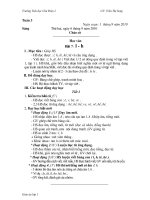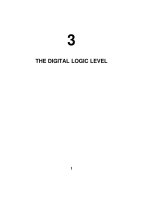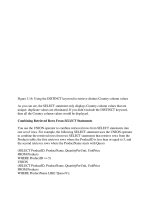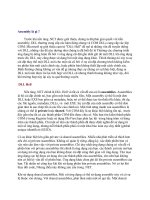Tài liệu E-business Part 1 of 3 ppt
Bạn đang xem bản rút gọn của tài liệu. Xem và tải ngay bản đầy đủ của tài liệu tại đây (2.81 MB, 27 trang )
1
Amy Feng
E-mail:
E-Business (1/3)E
E
-
-
Business (1/3)
Business (1/3)
2
Agenda
• Introduction to e-Business and e-Commerce
• e-Business Models
• Internet Marketing
• Online industry
2
3
What is E-Business
Need?
or
Want?
4
The Informed Buying Cycle
TV, Newspaper,TV, Newspaper,
MagazineMagazine
Book,Book,
(but, content itself(but, content itself
is the best marketing tool)is the best marketing tool)
Consumers Need Trust Trust
to Get Closer
ImagingImaging
Web Publishing,Web Publishing,
email,email,
Need InfoInfo
to Make Decision
ConsiderationConsideration
E-Payment
Fund Transfer,
Need Mechanism Mechanism
to Buy Actually
PurchasePurchase
1 2 3
StrategiesStrategies
Tactics
Rationale
3
5
Introduction: Transitioning to the Web
• The Internet has changed the way people communicate,
conduct business and manage their daily lives
• Technologies reviewed
• Resources used
6
History of the World Wide Web
• World Wide Web
• Locate and view multimedia-based documents on
almost any subject
• Makes information instantly and conveniently
accessible worldwide
• Possible for individuals and small businesses to get
worldwide exposure
• Changing the way business is done
4
7
Brief History of EC
• EC applications first
developed in the early
1970s
Electronic funds transfer
(EFT)
• Limited to:
• Large corporations
• Financial institutions
• A few other daring
businesses
8
Brief History of EC (cont.)
• Electronic data
interchange (EDI) —
electronic transfer of
documents:
• Purchase orders
• Invoices
• E-payments between
firms doing business
• Enlarged pool of
participants to include:
• Manufacturers
• Retailers
• Service providers
5
9
Brief History of EC (cont.)
• Interorganizationalsystems (IOS)
• Stock trading
• Travel reservation systems
• Internet became more commercialized in the early
1990s
• Almost all medium-and large-sized
organization in the world now has a Web site
• Most large corporations have comprehensive
portals
10
EC Definitions & Concepts
• Electronic Commerce (EC) is the process of buying, selling, or
exchanging products, services, and information via computer
networks………
• EC defined from these perspectives
• Communications
• Business process
• Service
• Online
• Collaborations
• Community
6
11
EC Definitions & Concepts (cont.)
• E-business is a broader definition of EC that includes
not just the buying and selling of goods and services,
but also
• Servicing customers
• Collaborating with business partners
• Conducting electronic transactions within an
organization
• Pure vs. Partial EC: based on the degree of
digitization of product, process, delivery agent
12
EC Definitions & Concepts (cont.)
E-business
E-commerce
7
13
EC Definitions & Concepts (cont.)
• Traditional commerce: all dimensions are physical
• Old-economy organizations (corporations)
• Perform all business off-line
• Sell physical products by means of physical agents
14
EC Definitions & Concepts (cont.)
• Pure EC: all dimensions are digital
• Pure online (virtual) organizations
• Pure Play
• New-economy organization
• Sell products or services only online
• Partial EC: a mix of digital and physical dimensions
• Conduct EC activities
• Do their primary business in the physical world
8
15
Electronic Markets vs.
Interorganizational Systems
• E-markets
Buyers and sellers meet to
exchange
• Goods
• Services
• Money
• Information
• Interorganizational
Information Systems (IOS)
Between two or more
organizations
• Routine transaction
processing
• Information flow
16
Classification of EC by the
Nature of the Transaction
• Business-to-business (B2B) : EC model in which all of
the participants are businesses or other organizations
• Business-to-consumer (B2C): EC model in which
businesses sell to individual shoppers
• Business-to-business-to-consumer (B2B2C): EC model
in which a business provides some product or service to a
client business; the client business maintains its own
customers, to whom the product or service is provided
9
17
Classification of EC by the
Nature of the Transaction (cont.)
• Consumer-to-business(C2B): individuals who
use the Internet to sell products or services to
organizations and /or seek sellers to bid on
products or services they need
• Consumer-to-consumer (C2C) : consumers sell
directly to other consumers
18
Classification of EC by the
Nature of the Transaction (cont.)
• Mobile commerce (m-commerce) —EC transactions
and activities conducted in a wireless environment
• Location-commerce— (l-commerce)
m-commerce transactions targeted to
individuals in specific locations, at specific times
10
19
Classification of EC by the
Nature of the Transaction (cont.)
• Intra-business (organizational) EC: EC category
that includes all internal organizational activities
that involve the exchange of goods, services, or
information among various units and individuals
in an organization
20
Classification of EC by the
Nature of the Transaction (cont.)
• Business-to-employee (B2E): EC model in which an
organization delivers services, information, or products to
its individual employees
• Collaborative commerce (c-commerce): EC model in
which individual or groups communicate or collaborate
online
• E-government: Government-to-citizens (G2C): EC
model in which a government entity buys or provides
good, services, or information to businesses or
individual citizens
11
21
Classification of EC by the
Nature of the Transaction (cont.)
• Exchange (electronic): a public e-market with
many buyers and sellers
• Exchange-to-exchange (E2E): EC model in
which electronic exchanges formally connect to
one another for the purpose of exchanging
information
22
e-Business and e-Commerce Overview
• Successful e-businesses are those that recognize the
needs of their target audiences and match those needs
with relevant content
• Seasoned professionals and young entrepreneurs
• e-Commerce
• Involves exchanges among customers, business
partners and the vendor
• e-Business
• Includes operations that are handled within the
business itself
12
23
e-Business and e-Commerce Overview
(cont.)
• Intense competition
• Businesses must adjust to new technologies and implement new
systems
• Customized production capabilities
• Finding and keeping key employees
• 24-by-7 maintenance responsibilities
• Must be reliable, fast, functional and user friendly
• Brick-and-mortar businesses
• Businesses that have only a physical presence
• Click-and-mortar businesses
• Businesses that have both an online and an offline presence
24
e-Business and e-Commerce Overview
(cont.)
• Virtual office
• All communications are conducted via phone, voice mail, fax,
e-mail and the emerging capabilities of the Internet
• Personalization
• Tailoring Web pages to users’ individual preferences and
letting users bypass irrelevant content
• Copyright infringement
• Privacy invasion
• The sale of personal data to another organization without the
consumer’s knowledge
• Tracking of Internet activity
• Unauthorized access to credit-card numbers, medical history
and criminal history
13
25
e-Business and e-Commerce Overview
(cont.)
26
e-Business and e-Commerce Overview
(cont.)
• Virtual office
• All communications are conducted via phone, voice mail, fax,
e-mail and the emerging capabilities of the Internet
• Personalization
• Tailoring Web pages to users’ individual preferences and
letting users bypass irrelevant content
• Copyright infringement
• Privacy invasion
• The sale of personal data to another organization without the
consumer’s knowledge
• Tracking of Internet activity
• Unauthorized access to credit-card numbers, medical history
and criminal history
14
27
e-Business Models
28
Introduction
• e-Business
• A company that has an online presence
• E-commerce businesses allow customers to sell, trade
and barter over the Web
• A company’s policy, operations, technology and
ideology define its business model
15
29
• A method of doing business by which a company
can generate revenue to sustain itself
• Spells out where the company is positioned in the
value chain
• Business models are a component of a business
plan or a business case
Business Models
30
Business Plans & Business Cases
• Business plan
A written document that
identifies the business goals
and outlines the plan of how
to achieve them
• Business case
A written document that is
used by managers to garner
funding for specific
applications or projects; its
major emphasis is the
justification for a specific
investment
16
31
The Content of a Business Plan
• Mission statement and
company description
• The management team
• The market and the
customers
• The industry and
competition
• The specifics of the
products and/or services
• Marketing and sales plan
• Operations plan
• Financial projections and
plans
• Risk analysis
• Technology analysis
32
Storefront Model
• Storefront model enables merchants to sell products on
the Web
• Transaction processing, security, online payment,
information storage
• E-commerce allows companies to conduct
business 24-by-7, all day everyday, worldwide
• An e-commerce storefront should include:
• Online catalog of products
• Order processing
• Secure payment
• Timely order fulfillment
17
33
Storefront Model (cont.)
34
Storefront Model (cont.)
18
35
Storefront Model (cont.)
36
• Storefront model enables merchants to sell products on
the Web
• Transaction processing, security, online payment,
information storage
• E-commerce allows companies to conduct
business 24-by-7, all day everyday, worldwide
• An e-commerce storefront should include:
• Online catalog of products
• Order processing
• Secure payment
• Timely order fulfillment
Storefront Model (cont.)
19
37
Shopping Cart Technology
• Shopping Cart
• An order-processing technology allowing customers
to accumulate lists of items they wish to buy as they
continue to shop
• Shopping cart is supported by
• Product catalog
• Merchant server
• Database technology
• Combine a number of purchasing methods to give
customers a wide array of options
38
Online Shopping Malls
• Wide selection of products and services
• Offers greater convenience than shopping at multiple
online shops
• Consumers can make multiple purchases in one
transaction
20
39
Auction Model
• Online auction sites
• Act as forums through which Internet users can log-on
and assume the role of either bidder or seller
• Collect a commission on every successful auction
• Sellers post items they wish to sell and wait for buyers
to bid
• Reserve price
• The minimum price a seller will accept in a given
auction
• Reverse auctions
• Allow the buyer to set a price as sellers compete to
match or even beat it
40
Auction Model (cont.)
eBay home page. (These materials have been reproduced by Prentice Hall with
the permission of eBay, Inc. COPYRIGHT © EBAY, INC. All Rights Reserved.)
21
41
Auction Model (cont.)
Placing a bid on eBay. (These materials have been reproduced by Prentice Hall with
the permission of eBay, Inc. COPYRIGHT © EBAY, INC. All Rights Reserved.)
42
Portal ModelPortal Model
• Portal sites
• Give visitors the chance to find almost everything
they are looking for in one place
• Horizontal portals
• Portals that aggregate information on a broad range
of topics
• Yahoo!, AltaVista, Google
• Vertical portals
• Portals that offer more specific information within a
single area of interest
• WebMD
22
43
Horizontal portals
44
Portal ModelPortal Model
• Portal sites
• Give visitors the chance to find almost everything
they are looking for in one place
• Horizontal portals
• Portals that aggregate information on a broad range
of topics
• Yahoo!, AltaVista, Google
• Vertical portals
• Portals that offer more specific information within a
single area of interest
• WebMD
23
45
Vertical portals
46
“Knowledge Portal”
Company PortalCompany Portal
Personal PortalPersonal Portal
Industry PortalIndustry Portal
Internet PortalInternet Portal
Customers Served
IT Complexity
Thin Client ASP Own IT
Enterprise Information Portal
Knowledge Portal
Employees as CustomersEmployees as Customers
24
47
Dynamic Pricing Models
• The Web has changed the way products are priced and
purchased
• Comparison pricing model
• Web sites using shopping bot technology to find the
lowest price for a given item
• Demand-sensitive pricing model
• Group buying reduces price as volume of sales
increase
• Name-your-price model
• Name-your-price for products and services
48
Dynamic Pricing Models (cont.)
• Bartering Model
• Individuals and business trade unneeded items for
items they desire
• Rebate Model
• Sites offer rebates on product at leading online retailers
in return for commission or advertising revenues
• Free offering model
• Free products and services generate high traffic
25
49
B2B E-commerce and EDI
• B2B e-business
• The electronic business relationship between two or
more companies
• Traditional EDI uses a value-added network or VAN
• A closed network that includes all members of a
production process
• XML (eXtensible Markup Language)
• A development technology similar to HTML
(Hypertext Markup Language)
• Improves the compatibility between disparate systems,
creating new market opportunities
50
XML









